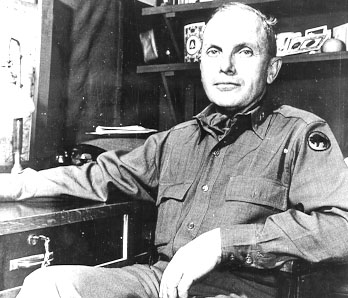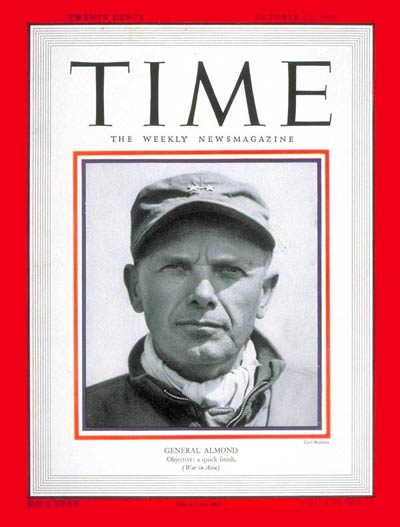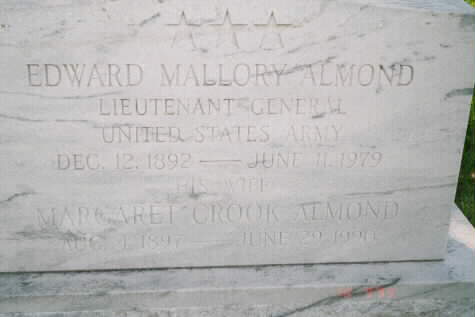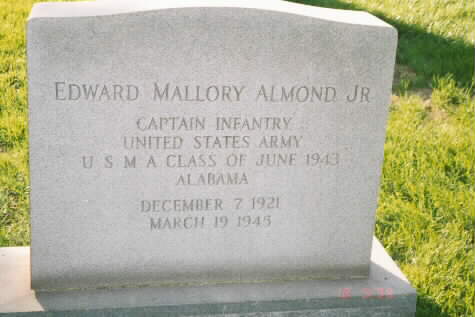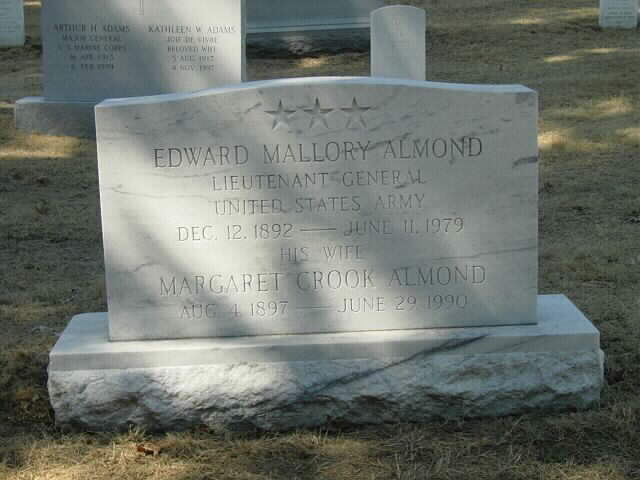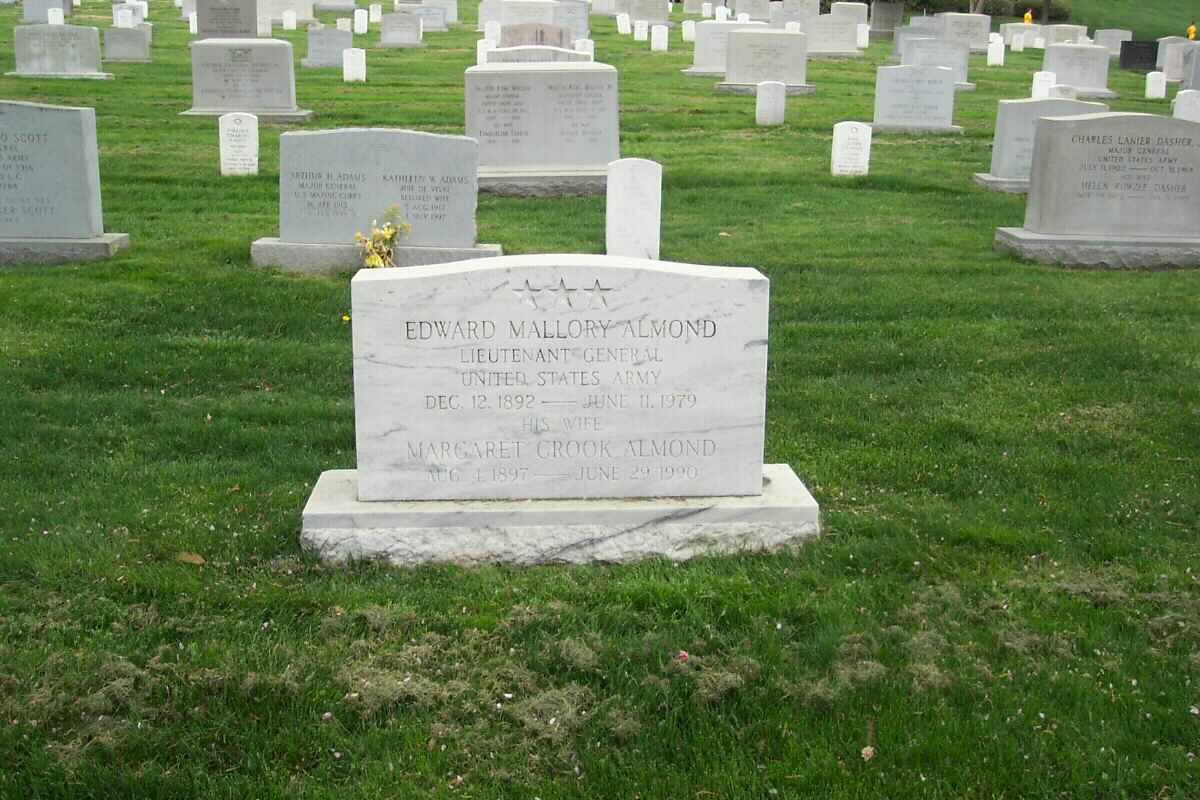US Army Photo
Born at Luray, Virginia, December 12, 1892, he graduated from Virginia Military Institute (VMI) in 1915. In November 1916 he was commissioned in the Infantry, receiving promotion to First Lieutenant in 1917.
In World War I he served with the 4th Div (Generals John L. Hines and George H. Cameron) in France from June 1918 into occupation period, receiving temporary rank of Major in October 1918.
He taught military science at Marion Institute, Alabama, 1919-1923 and, after attending the Infantry School, Fort Benning, Georgia, in 1924 taught there until 1928, August of which year was promoted to Major.
He graduated from the Command & General Staff School, Fort Leavenworth, Kansas, 1930. After a tour of duty in Philippines he attended the Army War College in 1934. From 1934 to 1938 he was attached to intelligence Division of the General Staff. Promoted to Lieutenant Colonel in September 1938, he completed the course at US Navy War College in 1940 and in January 1941 was assigned staff duty at VI Corps HQ, Providence, Rhode Island. Promoted to the temporary ranks of Colonel October 1941, Brigadier General Mar 1942, when was named assistant commander of the 93rd Infantry Division in Arizona. In July 1942 he took command of new 92nd Div (Negro) which he organized and, following its activation in October, trained in Alabama and Arizona (was given rank of temporary Major General in September 1942) until August 1944 when he took it overseas for service in Italy. The 92nd attacked the Ligurian Coast toward Massa and for months fought a seesaw battle up and down the Serchio Valley.
In April 1945 a major drive to north was spearheaded by famed 442nd Regiment (Nisei), a unit of the 92nd; La Spezia was taken, the German Gothic Line flanked, and the way to the Po Valley across the mountains opened. By the time of the German surrender on May 2, 1945 the 92nd held the coast north to Genoa.
He returned to US in August 1945 and placed in command of the 2nd Div, Camp Swift, Texas, in September and was promoted to the permanent rank of Colonel in December. In June 1946 he was transferred to Douglas MacArthur’s HQ staff in Tokyo, becoming deputy Chief of Staff, Far Eastern Command, January 1947. Promoted to the permanent rank of Major General, January 1948 (dating from September 1944), he became Chief of Staff, Far East Command, February 1949. In September 1950, soon after outbreak of Korean War he was named to command the newly created X Corps, assembled from 2 skeleton divisions and assorted other elements, to execute MacArthur’s plan for an amphibious assault at Inchon, midway up west coast of Korean peninsula. The landing, conducted by naval forces under Admiral Arthur D. Struble, took place on September 15. X Corps quickly took Seoul and linked up with Walton H. Walker’s 8th Army pushed north, trapping some 120,000 North Korean troops. In October, X Corps moved by sea around peninsula and landed unopposed at Wonsan, on the east coast of North Korea. Incorporating Republic of Korea I Corps into his command, he pushed north and reached the Chinese border at Yalu River by November 21. Massive Chinese counterattacks from November 25 forced UN forces to withdraw, and by December 11 X Corps had concentrated in the port of Hungnam, whence it embarked for Pusan, in South Korea, a huge operation involving 105,000 troops, nearly as many refugees, and all materiel, and was incorporated into 8th Army. Reentering the line in east-central Korea, X Corps was a central anchor in UN defense and took part in a gradual advance back across 38th parallel. He was promoted to temporary Lieutenant General in February 1951, and remained in command of X Corps until July. He was then placed in command of the Army War College, a post held until he retired in January 1953.
Distinguished Service Cross
Distinguished Service Medal
Silver Star
Purple Heart
He lived thereafter in Anniston, Alabama, where he was an executive in an insurance company and had numerous civic interests. December 12, 1892-June 11, 1979. Buried: Jun 15, 1979 in Section 2 of Arlington National Cemetery.
Buried with him are his son, Captain Edward Mallory Almond, Jr., who graduated from West Point in 1943 and who was killed-in-action in World War II on March 19, 1945, and his wife, Margaret Cook Almond, August 4, 1892 – June 29, 1990.
His son-in-law, Thomas T. Galloway, Major, United States Army Air Corps, was killed-in-action over France in July 1944. The Major was married to the General’s daughter, Margaret.
ALMOND, EDWARD MALLORY
Major General, United States Army
(First Award)
Citation:
The Distinguished Service Cross is presented to Edward M. Almond, Major General, U.S. Army, for extraordinary heroism in connection with military operations against an armed enemy of the United Nations while serving as Commanding General of X Corps.
Major General Almond distinguished himself by extraordinary heroism in action against enemy aggressor forces in the Republic of Korea during the period from 15 to 25 September 1950. During the seizure of Inchon, General Almond personally visited front line units, coordinated tactical efforts, and by his own fearless example aided them in seizing assigned objectives.
Following the fall of Inchon, General Almond personally led his troops in their rapid drive through enemy-held territory to seize Seoul, and to speed the disintegration of the enemy forces.
During the assault of the Han River, he moved to a forward position well beyond the line of friendly forces to observe and control the river crossing. Despite heavy enemy mortar fire directed at him, General Almond remained to supervise the air and artillery support which was protecting the first units of the Seventh Infantry Division crossing the river. Disregarding enemy mine fields and sniper fire, he proceeded to the crossing site to direct fire of amphibious tanks neutralizing enemy opposition which was impeding our crossing. By his inspirational leadership, his complete indifference to danger, and personal control of the battlefield, General Almond quickly concluded tactical operations which destroyed the enemy forces in the X Corps zone of action and saved countless lives in the forces under his command.
ALMOND, EDWARD MALLORY
Lieutenant General, United States Army
(Second Award)
Citation:
The Distinguished Service Cross (First Oak Leaf Cluster) is presented to Edward M. Almond, Lieutenant General, U.S. Army, for extraordinary heroism in connection with military operations against an armed enemy of the United Nations while serving as Commanding General, X Corps.
Lieutenant General Almond distinguished himself by extraordinary heroism in action against enemy aggressor forces during the massive offensive by three known Communist Armies against the X Corps, during the period from 16 through 25 May 1951.
General Almond personally directed the historic defense which contained this attack and resulted in crushing losses in enemy manpower and materiel. During this period General Almond distinguished himself by countless acts of individual heroism as well as providing the inspiration, leadership and tactical skill which contributed materially the success of this operation.
On 19 May 1951, while reconnoitering enemy positions in a light aircraft, he observed 250 enemy at a point forward of a friendly tank patrol. General Almond landed his plane by the tank column and sent the tank platoon leader in his aide’s plane to observe the enemy group. While with the tank column the enemy set up a machine gun within 500 yards of his position. Without regard for hostile fire from this gun, he directed tank fire which silenced the weapon. The tank platoon went on to destroy the 250 enemy.
On 21 May 1951, General Almond made an aerial reconnaissance before a tank column operating at Soksa-ri, Korea. While flying low over this area, General Almond received intense automatic-weapons fire. Again, without regard for personal safety, he located these weapons and personally directed their destruction. Again on 25 May 1951, he made four flights in an unarmed light plane through the enemy-held mountain pass between Hangye and the Umyang bridgehead on the Seyang River. Despite intense enemy small-arms and friendly artillery fire, he returned time and again to insure proper command and liaison between friendly forces operating at both ends of the pass. These specific acts, as well as countless visits to forward-most command posts, provided the inspiration and forceful leadership essential at this critical time.
ALMOND, EDWARD MALLORY
LG United States Army
DATE OF BIRTH: 12/12/1892
DATE OF DEATH: 06/11/1979
BURIED AT: SECTION 2 SITE 4937-A
ARLINGTON NATIONAL CEMETERY
ALMOND, MARGARET CROOK
DATE OF BIRTH: 08/04/1897
DATE OF DEATH: 06/29/1990
BURIED AT: SECTION 2 SITE 4937-A
ARLINGTON NATIONAL CEMETERY
Michael Robert Patterson was born in Arlington and is the son of a former officer of the US Army. So it was no wonder that sooner or later his interests drew him to American history and especially to American military history. Many of his articles can be found on renowned portals like the New York Times, Washingtonpost or Wikipedia.
Reviewed by: Michael Howard

